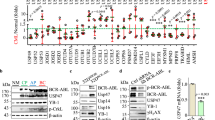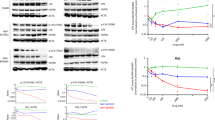Abstract
The calcineurin (Cn)–nuclear factor of activated T cells signaling pathway is critically involved in many aspects of normal T-cell physiology; however, its direct implication in leukemogenesis is still ill-defined. Glycogen synthase kinase-3β (GSK-3β) has recently been reported to interact with Cn in neuronal cells and is implicated in MLL leukemia. Our biochemical studies clearly demonstrated that Cn was able to interact with GSK-3β in T-cell acute lymphoblastic leukemia (T-ALL) cells, and that this interaction was direct, leading to an increased catalytic activity of GSK-3β, possibly through autophosphorylation of Y216. Sensitivity to GSK-3 inhibitor treatment correlated with altered GSK-3β phosphorylation and was more prominent in T-ALL with Pre/Pro immunophenotype. In addition, dual Cn and GSK-3 inhibitor treatment in T-ALL cells promoted sensitization to apoptosis through proteasomal degradation of X-linked inhibitor of apoptosis protein (XIAP). Consistently, resistance to drug treatments in primary samples was strongly associated with higher XIAP protein levels. Finally, we showed that dual Cn and GSK-3 inhibitor treatment in vitro and in vivo is effective against available models of T-ALL, indicating an insofar untapped therapeutic opportunity.
This is a preview of subscription content, access via your institution
Access options
Subscribe to this journal
Receive 12 print issues and online access
$259.00 per year
only $21.58 per issue
Buy this article
- Purchase on Springer Link
- Instant access to full article PDF
Prices may be subject to local taxes which are calculated during checkout






Similar content being viewed by others
References
Bassan R, Hoelzer D . Modern therapy of acute lymphoblastic leukemia. J Clin Oncol 2011; 29: 532–543.
Pui CH . Recent advances in acute lymphoblastic leukemia. Oncology (Williston Park) 2011; 25: 341 346–347.
Buchholz M, Ellenrieder V . An emerging role for Ca2+/calcineurin/NFAT signaling in cancerogenesis. Cell Cycle 2007; 6: 16–19.
Medyouf H, Ghysdael J . The calcineurin/NFAT signaling pathway: a novel therapeutic target in leukemia and solid tumors. Cell Cycle 2008; 7: 297–303.
Buchholz M, Schatz A, Wagner M, Michl P, Linhart T, Adler G et al. Overexpression of c-myc in pancreatic cancer caused by ectopic activation of NFATc1 and the Ca2+/calcineurin signaling pathway. EMBO J 2006; 25: 3714–3724.
Jauliac S, Lopez-Rodriguez C, Shaw LM, Brown LF, Rao A, Toker A . The role of NFAT transcription factors in integrin-mediated carcinoma invasion. Nat Cell Biol 2002; 4: 540–544.
Pham LV, Tamayo AT, Yoshimura LC, Lin-Lee YC, Ford RJ . Constitutive NF-kappaB and NFAT activation in aggressive B-cell lymphomas synergistically activates the CD154 gene and maintains lymphoma cell survival. Blood 2005; 106: 3940–3947.
Kim Y, Lee YI, Seo M, Kim SY, Lee JE, Youn HD et al. Calcineurin dephosphorylates glycogen synthase kinase-3 beta at serine-9 in neuroblast-derived cells. J Neurochem 2009; 111: 344–354.
Wang Z, Smith KS, Murphy M, Piloto O, Somervaille TC, Cleary ML . Glycogen synthase kinase 3 in MLL leukaemia maintenance and targeted therapy. Nature 2008; 455: 1205–1209.
Cross DA, Alessi DR, Cohen P, Andjelkovich M, Hemmings BA . Inhibition of glycogen synthase kinase-3 by insulin mediated by protein kinase B. Nature 1995; 378: 785–789.
Wang X, Paulin FE, Campbell LE, Gomez E, O'Brien K, Morrice N et al. Eukaryotic initiation factor 2B: identification of multiple phosphorylation sites in the epsilon-subunit and their functions in vivo. EMBO J 2001; 20: 4349–4359.
Sato N, Meijer L, Skaltsounis L, Greengard P, Brivanlou AH . Maintenance of pluripotency in human and mouse embryonic stem cells through activation of Wnt signaling by a pharmacological GSK-3-specific inhibitor. Nat Med 2004; 10: 55–63.
Bene MC, Castoldi G, Knapp W, Ludwig WD, Matutes E, Orfao A et al. Proposals for the immunological classification of acute leukemias. European Group for the Immunological Characterization of Leukemias (EGIL). Leukemia 1995; 9: 1783–1786.
Chou TC, Talalay P . Quantitative analysis of dose-effect relationships: the combined effects of multiple drugs or enzyme inhibitors. Adv Enzyme Regul 1984; 22: 27–55.
Sutherland C . What are the bona fide GSK-3 substrates? Int J Alzheimer Dis 2011; 2011: 505607.
Schimmer AD, Dalili S, Batey RA, Riedl SJ . Targeting XIAP for the treatment of malignancy. Cell Death Differ 2006; 13: 179–188.
Yang Y, Fang S, Jensen JP, Weissman AM, Ashwell JD . Ubiquitin protein ligase activity of IAPs and their degradation in proteasomes in response to apoptotic stimuli. Science 2000; 288: 874–877.
Erdmann F, Weiwad M, Kilka S, Karanik M, Patzel M, Baumgrass R et al. The novel calcineurin inhibitor CN585 has potent immunosuppressive properties in stimulated human T cells. J Biol Chem 2010; 285: 1888–1898.
Chiang MY, Xu L, Shestova O, Histen G, L'Heureux S, Romany C et al. Leukemia-associated NOTCH1 alleles are weak tumor initiators but accelerate K-ras-initiated leukemia. J Clin Invest 2008; 118: 3181–3194.
Shibasaki F, Price ER, Milan D, McKeon F . Role of kinases and the phosphatase calcineurin in the nuclear shuttling of transcription factor NF-AT4. Nature 1996; 382: 370–373.
Graef IA, Mermelstein PG, Stankunas K, Neilson JR, Deisseroth K, Tsien RW et al. L-type calcium channels and GSK-3 regulate the activity of NF-ATc4 in hippocampal neurons. Nature 1999; 401: 703–708.
Jope RS, Yuskaitis CJ, Beurel E . Glycogen synthase kinase-3 (GSK-3): inflammation, diseases, and therapeutics. Neurochem Res 2007; 32: 577–595.
Watcharasit P, Bijur GN, Zmijewski JW, Song L, Zmijewska A, Chen X et al. Direct, activating interaction between glycogen synthase kinase-3beta and p53 after DNA damage. Proc Natl Acad Sci USA 2002; 99: 7951–7955.
Mishra R . Glycogen synthase kinase 3 beta: can it be a target for oral cancer. Mol Cancer 2010; 9: 144.
Medyouf H, Alcalde H, Berthier C, Guillemin MC, dos Santos NR, Janin A et al. Targeting calcineurin activation as a therapeutic strategy for T-cell acute lymphoblastic leukemia. Nat Med 2007; 13: 736–741.
Ito C, Ribeiro RC, Behm FG, Raimondi SC, Pui CH, Campana D . Cyclosporin A induces apoptosis in childhood acute lymphoblastic leukemia cells. Blood 1998; 91: 1001–1007.
Gachet S, Genesca E, Passaro D, Irigoyen M, Alcalde H, Clemenson C et al. Leukemia-initiating cell activity requires calcineurin in T-cell acute lymphoblastic leukemia. Leukemia 2013; 27: 2289–2300.
Takemori N, Kodaira J, Toyoshima N, Sato T, Sakurai H, Akakura N et al. Successful treatment of immunoblastic lymphadenopathy-like T-cell lymphoma with cyclosporin A. Leuk Lymph 1999; 35: 389–395.
Medina M, Wandosell F . Deconstructing GSK-3: the fine regulation of its activity. Int J Alzheimer Dis 2011; 2011: 479249.
Maccario H, Perera NM, Davidson L, Downes CP, Leslie NR . PTEN is destabilized by phosphorylation on Thr366. Biochem J 2007; 405: 439–444.
Kitagawa K, Hiramatsu Y, Uchida C, Isobe T, Hattori T, Oda T et al. Fbw7 promotes ubiquitin-dependent degradation of c-Myb: involvement of GSK-3-mediated phosphorylation of Thr-572 in mouse c-Myb. Oncogene 2009; 28: 2393–2405.
Inuzuka H, Shaik S, Onoyama I, Gao D, Tseng A, Maser RS et al. SCF(FBW7) regulates cellular apoptosis by targeting MCL1 for ubiquitylation and destruction. Nature 2011; 471: 104–109.
Tamm I, Richter S, Oltersdorf D, Creutzig U, Harbott J, Scholz F et al. High expression levels of x-linked inhibitor of apoptosis protein and survivin correlate with poor overall survival in childhood de novo acute myeloid leukemia. Clin Cancer Res 2004; 10: 3737–3744.
Hundsdoerfer P, Dietrich I, Schmelz K, Eckert C, Henze G . XIAP expression is post-transcriptionally upregulated in childhood ALL and is associated with glucocorticoid response in T-cell ALL. Pediatr Blood Cancer 2010; 55: 260–266.
Belz K, Schoeneberger H, Wehner S, Weigert A, Bonig H, Klingebiel T et al. Smac mimetic and glucocorticoids synergize to induce apoptosis in childhood ALL by promoting ripoptosome assembly. Blood 2014; 124: 240–250.
Huang J, Zhang Y, Bersenev A, O'Brien WT, Tong W, Emerson SG et al. Pivotal role for glycogen synthase kinase-3 in hematopoietic stem cell homeostasis in mice. J Clin Invest 2009; 119: 3519–3529.
Acknowledgements
This work was supported by the Italian Association for Cancer Research (AIRC) grants to AA (IG#14032) and VT (MFGA#13053); Ministero dell’Istruzione, dell’Università e della Ricerca (MIUR) Ex 60% to AA and EP; and Istituto Oncologico Veneto 5 × 1000 fund to AA. We are grateful to Adolfo A Ferrando for sharing cells and reagents, Jon Aster for the MigR1-NOTCH1 L1601PΔP vector, Sonia Minuzzo and Marica Pinazza for providing T-ALL xenografts and Giorgia Pilotto for cell sorting.
Author contributions
VT performed and analyzed experiments. FB performed experiments. VA and SI provided primary T-ALL xenografts. JY performed bioinformatical analysis. GB provided primary T-ALL samples and clinical-immunophenotypical data. AA shared reagents and analyzed data. EP designed and performed experiments, directed research, analyzed data and wrote the paper. All the authors read and edited the manuscript.
Author information
Authors and Affiliations
Corresponding author
Ethics declarations
Competing interests
The authors declare no conflict of interest.
Additional information
Supplementary Information accompanies this paper on the Leukemia website
Supplementary information
Rights and permissions
About this article
Cite this article
Tosello, V., Bordin, F., Yu, J. et al. Calcineurin and GSK-3 inhibition sensitizes T-cell acute lymphoblastic leukemia cells to apoptosis through X-linked inhibitor of apoptosis protein degradation. Leukemia 30, 812–822 (2016). https://doi.org/10.1038/leu.2015.335
Received:
Revised:
Accepted:
Published:
Issue Date:
DOI: https://doi.org/10.1038/leu.2015.335
This article is cited by
-
Inhibition of Noncanonical Ca2+ Oscillation/Calcineurin/GSK-3β Pathway Contributes to Anti-Inflammatory Effect of Sigma-1 Receptor Activation
Neurochemical Research (2022)
-
Identification of an Epi-metabolic dependency on EHMT2/G9a in T-cell acute lymphoblastic leukemia
Cell Death & Disease (2022)
-
GSK-3: a multifaceted player in acute leukemias
Leukemia (2021)
-
Calcineurin Immune Signaling in Response to Zinc Challenge in the Naked Carp Gymnocypris eckloni
Bulletin of Environmental Contamination and Toxicology (2021)
-
Pharmacophore-based screening and drug repurposing exemplified on glycogen synthase kinase-3 inhibitors
Molecular Diversity (2017)



